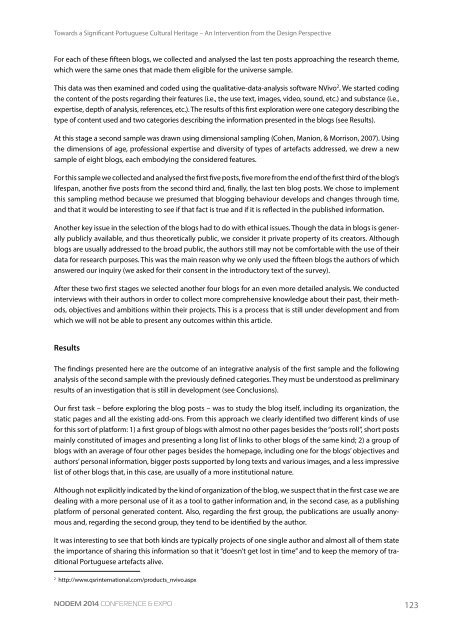NODEM 2014 Proceedings
NODEM 2014 Proceedings
NODEM 2014 Proceedings
You also want an ePaper? Increase the reach of your titles
YUMPU automatically turns print PDFs into web optimized ePapers that Google loves.
Towards a Significant Portuguese Cultural Heritage – An Intervention from the Design Perspective<br />
For each of these fifteen blogs, we collected and analysed the last ten posts approaching the research theme,<br />
which were the same ones that made them eligible for the universe sample.<br />
This data was then examined and coded using the qualitative-data-analysis software NVivo 2 . We started coding<br />
the content of the posts regarding their features (i.e., the use text, images, video, sound, etc.) and substance (i.e.,<br />
expertise, depth of analysis, references, etc.). The results of this first exploration were one category describing the<br />
type of content used and two categories describing the information presented in the blogs (see Results).<br />
At this stage a second sample was drawn using dimensional sampling (Cohen, Manion, & Morrison, 2007). Using<br />
the dimensions of age, professional expertise and diversity of types of artefacts addressed, we drew a new<br />
sample of eight blogs, each embodying the considered features.<br />
For this sample we collected and analysed the first five posts, five more from the end of the first third of the blog’s<br />
lifespan, another five posts from the second third and, finally, the last ten blog posts. We chose to implement<br />
this sampling method because we presumed that blogging behaviour develops and changes through time,<br />
and that it would be interesting to see if that fact is true and if it is reflected in the published information.<br />
Another key issue in the selection of the blogs had to do with ethical issues. Though the data in blogs is generally<br />
publicly available, and thus theoretically public, we consider it private property of its creators. Although<br />
blogs are usually addressed to the broad public, the authors still may not be comfortable with the use of their<br />
data for research purposes. This was the main reason why we only used the fifteen blogs the authors of which<br />
answered our inquiry (we asked for their consent in the introductory text of the survey).<br />
After these two first stages we selected another four blogs for an even more detailed analysis. We conducted<br />
interviews with their authors in order to collect more comprehensive knowledge about their past, their methods,<br />
objectives and ambitions within their projects. This is a process that is still under development and from<br />
which we will not be able to present any outcomes within this article.<br />
Results<br />
The findings presented here are the outcome of an integrative analysis of the first sample and the following<br />
analysis of the second sample with the previously defined categories. They must be understood as preliminary<br />
results of an investigation that is still in development (see Conclusions).<br />
Our first task – before exploring the blog posts – was to study the blog itself, including its organization, the<br />
static pages and all the existing add-ons. From this approach we clearly identified two different kinds of use<br />
for this sort of platform: 1) a first group of blogs with almost no other pages besides the “posts roll”, short posts<br />
mainly constituted of images and presenting a long list of links to other blogs of the same kind; 2) a group of<br />
blogs with an average of four other pages besides the homepage, including one for the blogs’ objectives and<br />
authors’ personal information, bigger posts supported by long texts and various images, and a less impressive<br />
list of other blogs that, in this case, are usually of a more institutional nature.<br />
Although not explicitly indicated by the kind of organization of the blog, we suspect that in the first case we are<br />
dealing with a more personal use of it as a tool to gather information and, in the second case, as a publishing<br />
platform of personal generated content. Also, regarding the first group, the publications are usually anonymous<br />
and, regarding the second group, they tend to be identified by the author.<br />
It was interesting to see that both kinds are typically projects of one single author and almost all of them state<br />
the importance of sharing this information so that it “doesn’t get lost in time” and to keep the memory of traditional<br />
Portuguese artefacts alive.<br />
2<br />
http://www.qsrinternational.com/products_nvivo.aspx<br />
<strong>NODEM</strong> <strong>2014</strong> Conference & Expo<br />
123


